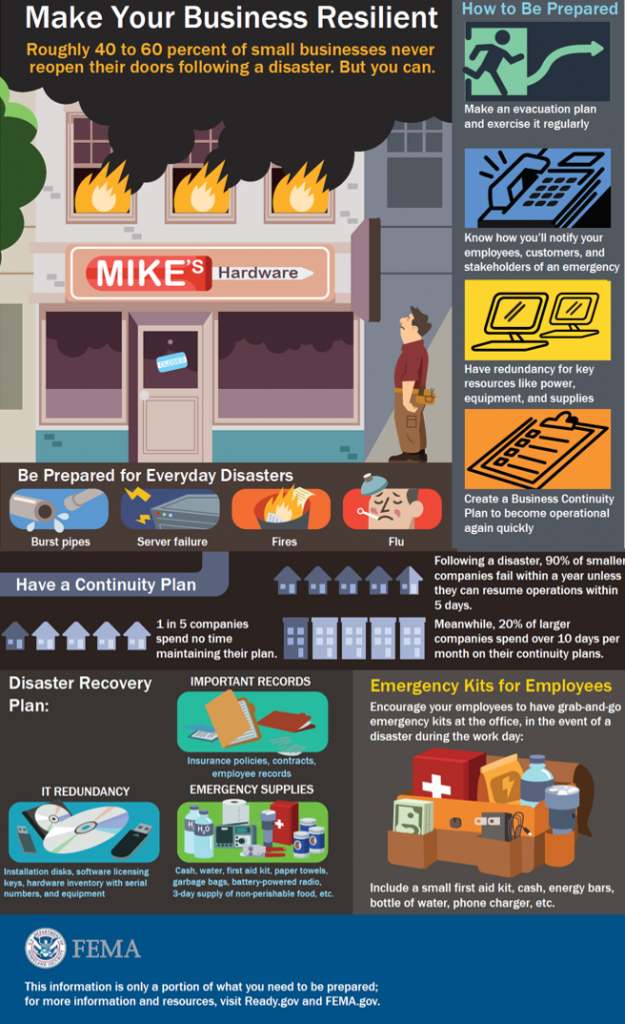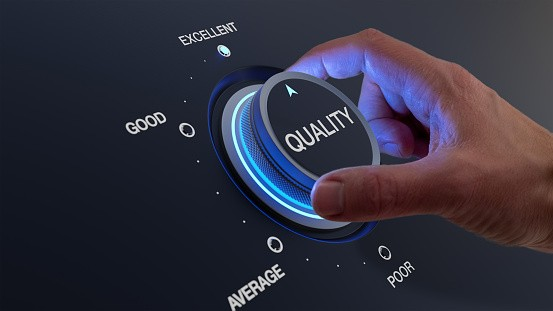According to FEMA, approximately 40-60% of “small businesses never reopen their doors following a disaster.”
Your business doesn’t have to be part of that statistic.

No one likes to think of doom and gloom, but when facing a disaster, it’s better to be prepared than caught off-guard.
Whether you refer to it as a crisis, disaster, or emergency, it warrants your attention since, left unchecked, it can be catastrophic to your company’s ability to operate. These events can come in the form of:
- Pandemic
- Bad press
- Faulty product/service
- Utility Outage
- Disgruntled Employee
- Terrorist Attack
- Theft
- Cybersecurity Breach
- Physical Security
- Breach
- Fire
- Flood
- Unexpected Death
- Dramatic Change in Customer Preferences
- E-Virus
- Extreme weather
And though this is not an exhaustive list, it gives you an idea of the various threats to your company’s longevity. As entrepreneurs and executives, we have a particular resilience that lends itself well to leading through crisis.
Here are 3 Tools for Building Your Business’ Immunity:
Download Business Immunity Kit
As the world deals with the COVID-19 (coronavirus) pandemic, businesses of all sizes are facing operational challenges. While some are struggling to keep their doors open, others realize they don’t have the capacity to handle more demand for their products or services. Either way, these three tools equip your small business with the armor necessary to protect your greatest assets.
Let’s examine each of these three tools in more detail.
Tool #1: Pre-Mortem
The Pre-Mortem was first introduced in 2007 by Gary Klein in a Harvard Business Review article. It is based on “prospective hindsight,” which involves generating an explanation for a future event as if it has already happened. Though presented as a means of saving projects from failure, the Pre-Mortem can also be applied to an overall company. By working backwards, leaders are empowered with prospective hindsight and can develop contingency plans to execute in the event one of the reasons or causes comes to fruition.
Unlike a post-mortem performed following expiration, a pre-mortem is performed while the business is still up and running (alive). The idea is that a project or managerial team comes together to imagine the reasons or causes for the worst outcome – the business or project’s failure.
The Pre-Mortem is useful for determining contingency plans and troubleshooting guidelines in the event of an emergency or crisis which, unchecked, can cause the company to fail. It can be likened to an insurance policy, a Will & Trust, or even a Power of Attorney document – all of which serve as backup plans to execute when a major changes occur. While it’s true that you can’t think of every worst-case scenario, the Pre-Mortem is an excellent tool to jumpstart the conversation for contingency planning.
Tool #2: Failure Modes & Effects Analysis (FMEA)
Unlike the Pre-Mortem, the FMEA is performed at a micro-level. It is used to analyze failures of the existing system/process so that failure will either be mitigated or eliminated with the improved system/process (Future State). According to the American Society for Quality (ASQ), the “FMEA is a step-by-step approach for identifying all possible failures in a design, [business] process, or a product or service. “‘Failure Modes’ means the ways, or modes, in which something might fail. Failures are any defects, especially ones that affect the customer, and can be potential or actual. ‘Effects Analysis’ refers to studying the consequences of those failures.”
Tool #3: Disaster Recovery & Business Continuity Plan
Business Continuity refers to your company’s ability to respond and operate during an emergency event. It’s about workflow continuation. Disaster Recovery refers to your company’s ability to respond and recover after an emergency event. It’s about information restoration. Together, business continuity and disaster recovery arms your company with protective measures to ensure the safety of people, property and processes.
The Disaster Recovery & Business Continuity Plan is like your company’s insurance policy for operations. You don’t need it until you need it. Its intent is to provide a comprehensive response and deployment system whenever daily operations are threatened due to an emergency.
_______________________________________________
In the following video, you’ll learn more about these three tools, why your business must have them, and how to implement them. Combined, they serve as powerful antibodies to stave off the dangers of declining revenue during disaster. Conversely, they can also serve as a catalyst if your business needs to increase bandwidth during disaster.
You can view and download the full presentation here:
Protect your most mission-critical operations and workflows. Download all three tools in this Business Immunity Kit. Each tool comes with specific instructions to customize for your small business.
Download Business Immunity Kit
As always, we’re here if you need further support in implementing these tools in your company. Just contact us to schedule some personalized time with us!












